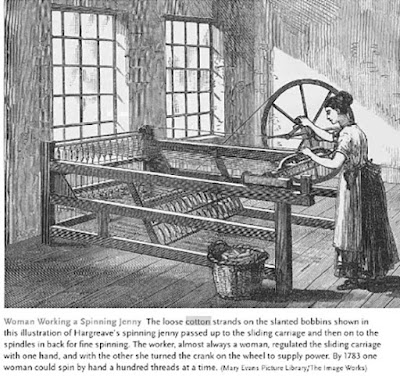When reading textile history one is struck by the early specialization in manufacturing processes in America and Europe. Cotton from boll to yardage involved many steps and fabric mills often focused on only one or two of those steps.
We'll look at the Amoskeag Mills in New Hampshire for a mill first specializing in spinning yarn and later weaving cotton cloth Their history indicates that Benjamin Prichard and the Stevens brothers bought the water power rights on the Merrimack River at what would become Manchester, New Hampshire where they erected a spinning mill in 1809 or 1810. Their spinning machinery was sold to them by Samuel Slater of Rhode Island, machinery that turned raw cotton into yarns of various thickness and weights.
The Amoskeag Cotton & Woolen Manufacturing Company's spinning yarn then went to local weavers who wove cotton cloth at home. A skilled and industrious home weaver could weave about 10-13 yards a day. Both men and women earned money at their home looms.
As industry evolved (and the mill owners became more "acquainted" with their product) the factory with its used and fractious spinning machinery became a more sophisticated enterprise incorporated in 1831, adding weaving machinery to produce yardage of "sheetings, shirtings and tickings." They commissioned a local manufacturer to copy an Arkwright spinning machine that worked better than the second-hand machinery.

Tickings: Woven pattern, defined in a recent edition of Fairchild's Dictionary of Textiles
Weaving mill employees with their shuttles.
Amoskeag also wove seamless cotton bags with a small area of
ticking stripe at a specialized branch established in 1856. Users personalized
these with initials etc. so their local grain dealer
could return the bag to the right owner.
See a piece of Amoskeag ticking from about 1870
at the New Hampshire Historical Society here:
The weaving mill was well-known throughout the 19th century for cloth production.
Library of Congress
Trade mark registration for a ticking line, 1876, a hot year for the product
Boston Evening Transcript
As far as I can tell Pearl River, Amoskeag and Massabesie are
all Amoskeag trademark names.
Text from the 2013 edition of Fairchild's
Levi Strauss purchased his "Jeans cloth" or blue denim from Amoskeag until 1915.
The teens during World War I were the most profitable years for the company.
Woven patterned cloth and perhaps plain sheeting on the looms in the
"Weave Room" at Amoskeag, early 20th c.
Do note that the Dress Gingham (gingham refers here to the process of weaving yarn-dyed cotton cloth)
is advertised as "patterns of checks, broken plaids and plain colors." Amoskeag was associated with woven pattern---not prints.
When they decided to manufacture prints they used another name and built new mills.
Printing branch name changes: Manchester Mills 1839
to Merrimack Mills (already used for a business in Lowell)
to Manchester Print Works
Delaine with coloring and stripes
typical of pre-Civil War ladies' fashion. Delaine
is a combination weave.
Printing was initially confined to the popular clothing cloth delaine, a wool or wool combination,
rather than cotton. Adapting to fashions, the printing mills changed focus between 1845 and 1865, eventually specializing in cotton.
Manchester Print Works built 1845
Feather pillows were an expensive item in 1910
Los Angeles Evening Express
Amoskeag with it's reliable woven cloth weathered financial ups and downs for about 130 years until 1936. Like so many other long-established businesses the mills closed in the Great Depression.
Library of Congress
Carl Mydans, 1936
1828 English baptism records show a variety of specific
textile jobs.
Next post we'll look at a Cotton Printing Mill in England where many were employed
at specific, often-mentioned occupations.
Read More:
The Amoskeag Manufacturing Co. of Manchester, New Hampshire: A History by George Waldo Browne



















































